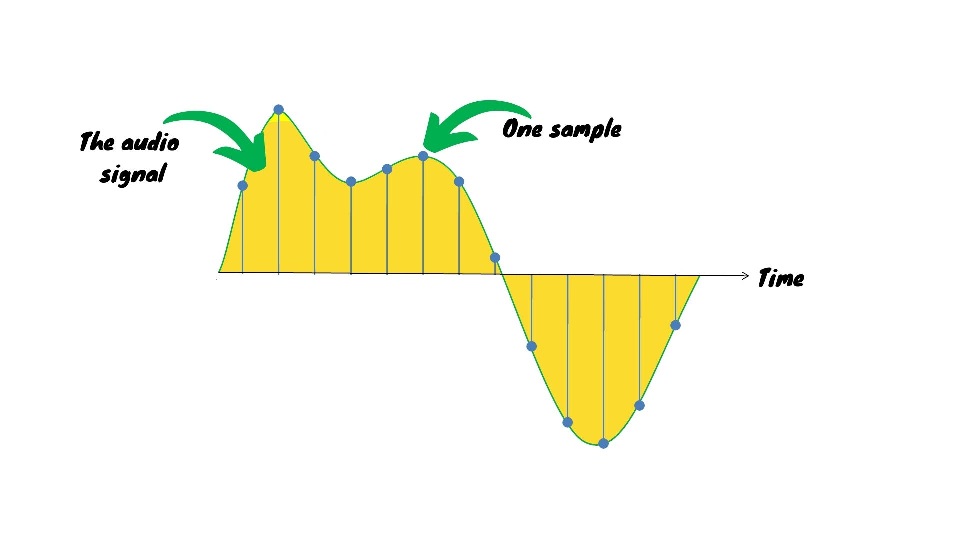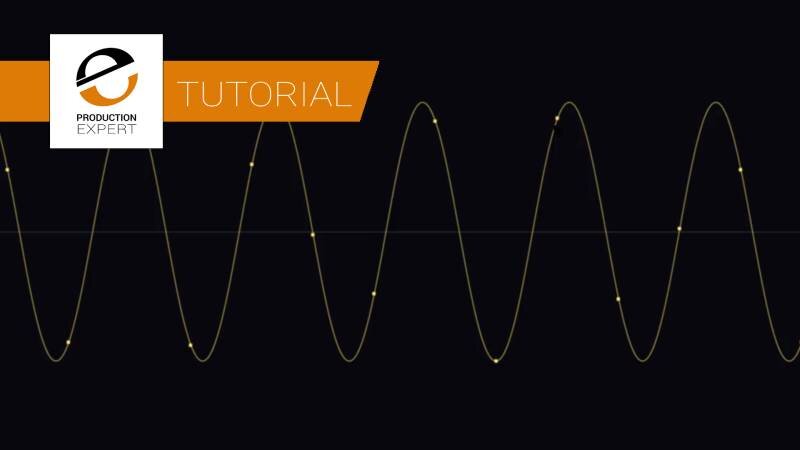The sample rate for recording refers to the frequency at which audio recordings are sampled. It is a crucial factor in determining the quality of a recording.
A higher sample rate can result in better sound quality, but also increases file size and requires more processing power. The most commonly used sample rates for music production and audio recording are 44. 1 kHz and 48 kHz. However, higher sample rates, such as 96 kHz or 192 kHz, can provide greater detail and accuracy in sound reproduction.
It is important to choose a sample rate that is appropriate for the intended use of the recording. We will explore the importance of sample rates in recording and how to choose the right one for your projects.

Credit: www.joecrowtheaudiopro.com
Factors To Consider When Choosing Sample Rate
Choosing the right sample rate is essential for recording high-quality audio. Factors to consider include the desired sound quality, available storage space, and compatibility with editing software.
Factors to Consider When Choosing Sample Rate When it comes to digital recording, sample rate refers to the number of samples per second of audio that are recorded. The sample rate you choose can have a significant impact on the quality, storage space, and compatibility of your recordings. Here are the key factors to consider when choosing the best sample rate for your needs. Audio Quality The sample rate you select will determine the frequency response of your recordings. Higher sample rates provide a wider frequency range and more accurate representation of audio, especially in higher frequencies. For high-quality recordings, you should consider a sample rate of 48 kHz or higher. However, keep in mind that higher sample rates come with larger file sizes, requiring more storage space. Storage Space The sample rate you choose has a direct impact on the size of your audio files. The higher the sample rate, the larger your audio files will be. This means that if you’re on a limited storage budget, it’s best to use a lower sample rate. A sample rate of 44.1 kHz is commonly used for music recordings, but if you’re recording vocals or speech, you could get away with a 22.05 kHz sample rate. Compatibility The sample rate you choose must be compatible with the devices and software you intend to use to edit and playback your recordings. Most modern devices support a range of sample rates, so you shouldn’t experience any issues as long as you choose a commonly used sample rate. For instance, a sample rate of 48 kHz is supported by most recording software. In conclusion, selecting the right sample rate for your recording requires careful consideration of the audio quality, storage space, and compatibility. While higher sample rates may offer better audio quality, keep in mind the larger file sizes that come with them. Lastly, ensure that the sample rate you choose is supported by your recording device and editing software.

Credit: www.soundonsound.com
Common Sample Rates Used In Recording
Sample rate is the number of samples of audio carried per second, expressed in Hertz (Hz). It determines the quality of audio recordings. The higher the sample rate, the better the audio quality. Common sample rates used in recording include 44.1 kHz, 48 kHz, 88.2 kHz, and 96 kHz.
44.1 Khz
44.1 kHz is the sample rate used in CDs. It provides high-quality audio recordings and is supported by most digital audio equipment. It is a standard sample rate for audio recording in music production, podcasting, and other audio content. It is a reliable option for recording, editing, and producing quality audio.
48 Khz
48 kHz is the sample rate used in digital video production. It is also standard for audio recording in film soundtracks and TV broadcast productions. This sample rate provides high-quality audio recordings with improved frequency and dynamic range. It is a good option for recording studio-quality music and creating immersive sound experiences.
88.2 Khz
88.2 kHz is a high-resolution sample rate used in audiophile digital music repositories and high-quality audio recording applications. It provides high-fidelity audio recordings with superior clarity and details. This sample rate is useful for recording orchestral music, jazz, and other genres that require high dynamic range and fine nuances of sound.
96 Khz
96 kHz is the highest common sample rate used in professional audio recording. It provides ultra-high-quality audio recordings with exceptional clarity and accuracy. This sample rate is useful for recording classical music, opera, and other genres that require the highest level of audio performance.
Choosing the right sample rate depends on the intended use of your audio recording. Higher sample rates provide better audio fidelity but require larger file sizes and more processing power. Consider your project requirements and equipment capabilities when selecting your sampling rate.
How To Choose The Right Sample Rate For Your Recording
Choosing the appropriate sample rate is crucial in achieving high-quality recording results. It determines the accuracy of the recorded sound, with higher sample rates providing better sound quality but requiring more storage space and processing power. To find the right sample rate for your recording, you should consider your equipment, the type of recording you are making, and your intended final output.
Choosing the right sample rate for your recording is a crucial step in audio production. Sample rate refers to the number of samples per second taken from an audio signal and is measured in Hertz (Hz). A higher sample rate provides better quality audio, but it also requires more storage space. In this article, we’ll help you choose the right sample rate for your recording by considering three factors: the genre of music, the type of instrument, and the destination of the recording.
Genre Of Music
The genre of music you’re recording can have an impact on the sample rate you choose. If you’re recording classical or acoustic music, a higher sample rate (e.g. 96kHz) may be necessary to capture the nuances of the performance, as these genres are often recorded in more quiet environments. However, for genres such as hip-hop or EDM, a lower sample rate (e.g. 44.1kHz) can still produce high-quality audio that matches the production style.
Type Of Instrument
The type of instrument being recorded can also affect the sample rate you choose. For example, recording a solo vocalist may not require a high sample rate since the human voice doesn’t have the same frequency range as some instruments like a drum kit, piano, or strings. A low to medium sample rate like 44.1kHz or 48kHz can suffice for vocal recording. On the other hand, for percussive instruments like drums, a higher sample rate like 96kHz may be needed to capture the transient details of the instrument.
Destination Of The Recording
Consider the destination of the recording when choosing your sample rate. If you’re recording for CD release, then the standard sample rate of 44.1kHz with a bit depth of 16-bit is all you need. However, if you’re recording for film or video games, then a higher sample rate like 48kHz or even 96kHz (with 24-bit depth) may be necessary to ensure compatibility. In some cases, the destination may require lower sample rates, such as when streaming audio to mobile devices.
Conclusion
In conclusion, choosing the right sample rate for recording is based on the genre of music, type of instrument and the destination of the recording. By considering these factors, you can ensure that your recordings sound great and are compatible with various platforms. Remember that higher sample rates come with larger file sizes, so choose the sample rate that fits the recording’s needs without sacrificing quality.

Credit: www.production-expert.com
Frequently Asked Questions For Sample Rate For Recording
Is It Better To Record In 44.1 Or 48?
It depends on the intended use of the recording. For music, 48 kHz is generally preferred for higher fidelity. However, for audio that will only be used online or for speech, 44. 1 kHz is sufficient and produces smaller file sizes.
The main goal is to choose a sample rate that matches your project’s needs and requirements.
At What Sample Rate Should I Record?
Record at a sample rate of 44. 1 kHz or 48 kHz for most applications. These rates are standard for audio production and provide a good balance between audio quality and file size. However, you may need to adjust the sample rate based on the specific needs of your project or equipment.
Should I Record 48khz Or 96khz?
Recording at 48kHz will suffice for most applications. It is a standard sampling rate and produces good quality sound. However, if you plan to manipulate the audio extensively or want to capture more detail, 96kHz would be a better choice.
Keep in mind, higher sampling rates require more storage space.
What Is A Good Sample Size For Recording?
The minimum sample size needed for reliable recordings varies depending on the type and purpose of the recording. Generally, a sample size of at least 30 is considered acceptable, but the larger the sample size, the more accurate the results will be.
Conclusion
Recording with the appropriate sample rate is crucial for achieving high-quality audio output. Selecting the right sample rate and bit depth combo depends on the desired final output and the environment where it is used. These factors impact the overall consumer experience positively or negatively.
Understanding the importance of sample rate in recording enables artists and creators to deliver exceptional audio content. Optimize your audio recording’s quality by choosing the correct sample rate—the key to enhance your listeners’ audio experience.